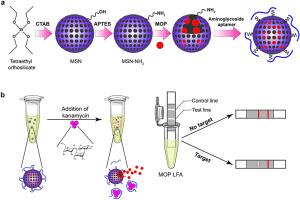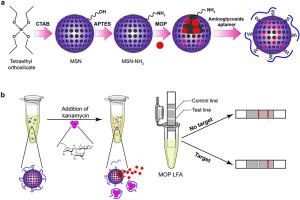An innovative biosensor utilizing aptamer-gated mesoporous silica nanoparticles for determination of aminoglycoside antibiotics through indirect-lateral flow
IF 5.7
2区 化学
Q1 CHEMISTRY, ANALYTICAL
引用次数: 0
Abstract
Background
Aminoglycoside antibiotics (AGs) are commonly utilized in both human and veterinary medicine to treat and manage a range of infections. These antibiotics are recognized for their narrow therapeutic window, with an overdose potentially resulting in severe side effects like kidney and ear damage. Hence, the implementation of a quick, precise, and on-the-spot testing method is crucial in clinical settings. In the present investigation, we designed an innovative indirect lateral flow assay (LFA) utilizing aptamers to detect kanamycin, a type of aminoglycoside antibiotics. We prepared mesoporous silica nanoparticles (MSNs) functionalized with amino groups, loaded them with morphine (MOP), and then sealed them with aminoglycoside aptamers (Apt). The complex of gated-MSNs@Apt was tested using the MOP LFA in the presence or absence of kanamycin antibiotics.
Results
The indirect LFA system displayed a single colored line in the test line for positive samples, whereas it exhibited double colored lines in both the control line and test line for negative samples. Our custom-designed LFA biosensors demonstrated two linear ranges, from 10 nM to 350 nM and 500 nM–1500 nM, with a limit of detection (LOD) of 5 nM in serum media under optimized conditions. The introduced indirect LFA biosensor was effectively utilized to detect kanamycin, achieving a satisfactory recovery rate of 92.9–109.9 % with RSD of 1.68–7.73 % in serum samples.
Significance
In general, the created LFA system offers a portable, straightforward, and affordable approach for point-of-care (POC) identification of kanamycin and other AGs.


利用aptamer门控介孔二氧化硅纳米粒子的创新生物传感器,通过间接侧向流测定氨基糖苷类抗生素
背景氨基糖苷类抗生素(AGs)通常用于人类和兽医治疗和控制各种感染。这类抗生素的治疗窗口较窄,过量使用可能会导致严重的副作用,如肾脏和耳朵损伤。因此,在临床环境中实施快速、精确的现场检测方法至关重要。在本研究中,我们设计了一种创新的间接侧流检测法(LFA),利用aptamers来检测卡那霉素(一种氨基糖苷类抗生素)。我们制备了具有氨基官能团的介孔二氧化硅纳米颗粒(MSNs),在其中添加吗啡(MOP),然后用氨基糖苷类适配体(Apt)将其密封。在卡那霉素抗生素存在或不存在的情况下,使用 MOP LFA 对门控-MSNs@Apt 复合物进行测试。在优化条件下,我们定制设计的 LFA 生物传感器在血清培养基中显示出 10 nM 至 350 nM 和 500 nM 至 1500 nM 两个线性范围,检测限(LOD)为 5 nM。总体而言,该 LFA 系统为卡那霉素和其他 AGs 的 POC 鉴定提供了一种便携、直接、经济的方法。
本文章由计算机程序翻译,如有差异,请以英文原文为准。
求助全文
约1分钟内获得全文
求助全文
来源期刊

Analytica Chimica Acta
化学-分析化学
CiteScore
10.40
自引率
6.50%
发文量
1081
审稿时长
38 days
期刊介绍:
Analytica Chimica Acta has an open access mirror journal Analytica Chimica Acta: X, sharing the same aims and scope, editorial team, submission system and rigorous peer review.
Analytica Chimica Acta provides a forum for the rapid publication of original research, and critical, comprehensive reviews dealing with all aspects of fundamental and applied modern analytical chemistry. The journal welcomes the submission of research papers which report studies concerning the development of new and significant analytical methodologies. In determining the suitability of submitted articles for publication, particular scrutiny will be placed on the degree of novelty and impact of the research and the extent to which it adds to the existing body of knowledge in analytical chemistry.
 求助内容:
求助内容: 应助结果提醒方式:
应助结果提醒方式:


